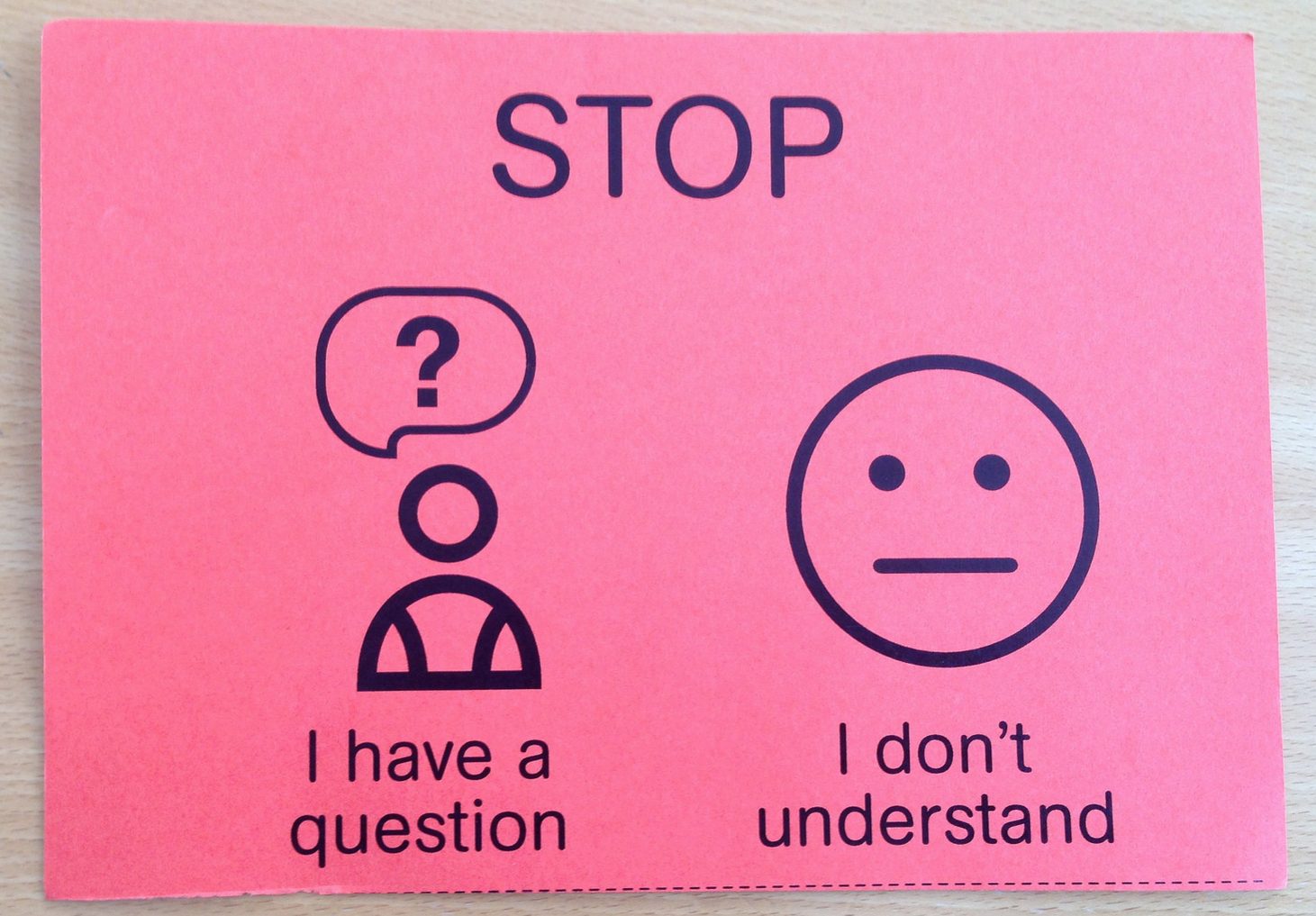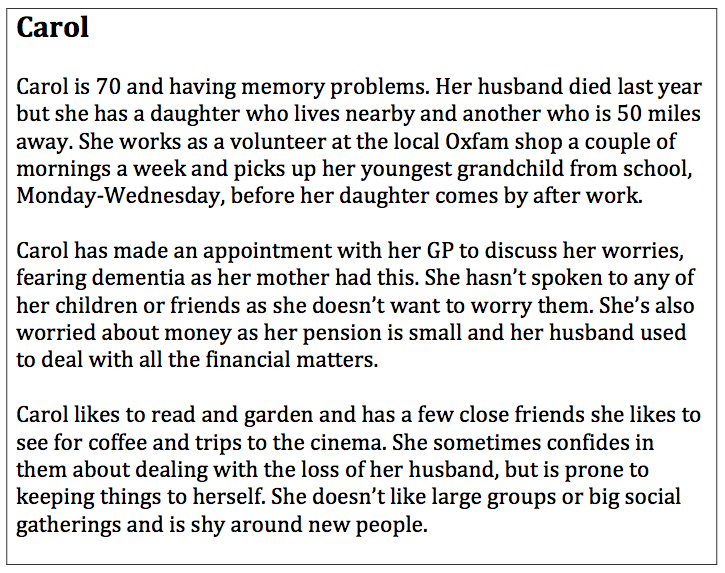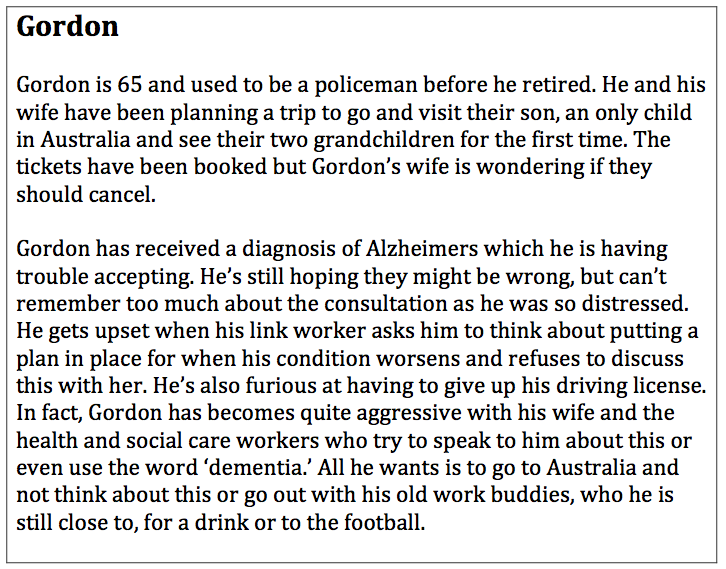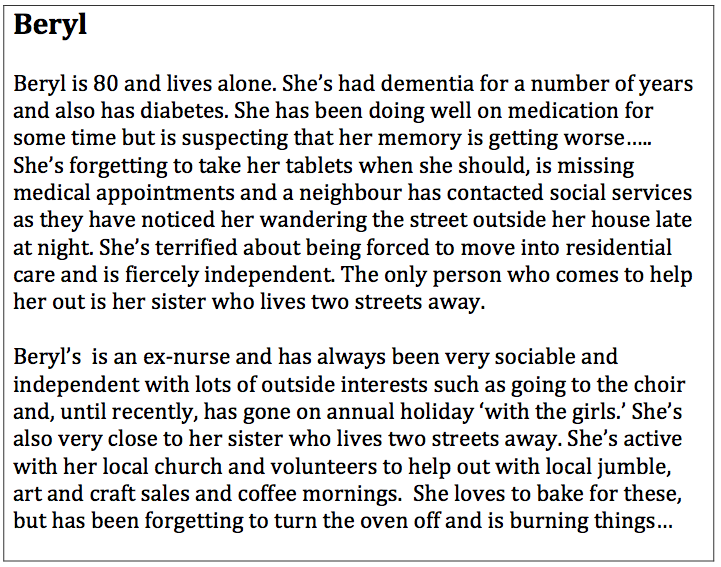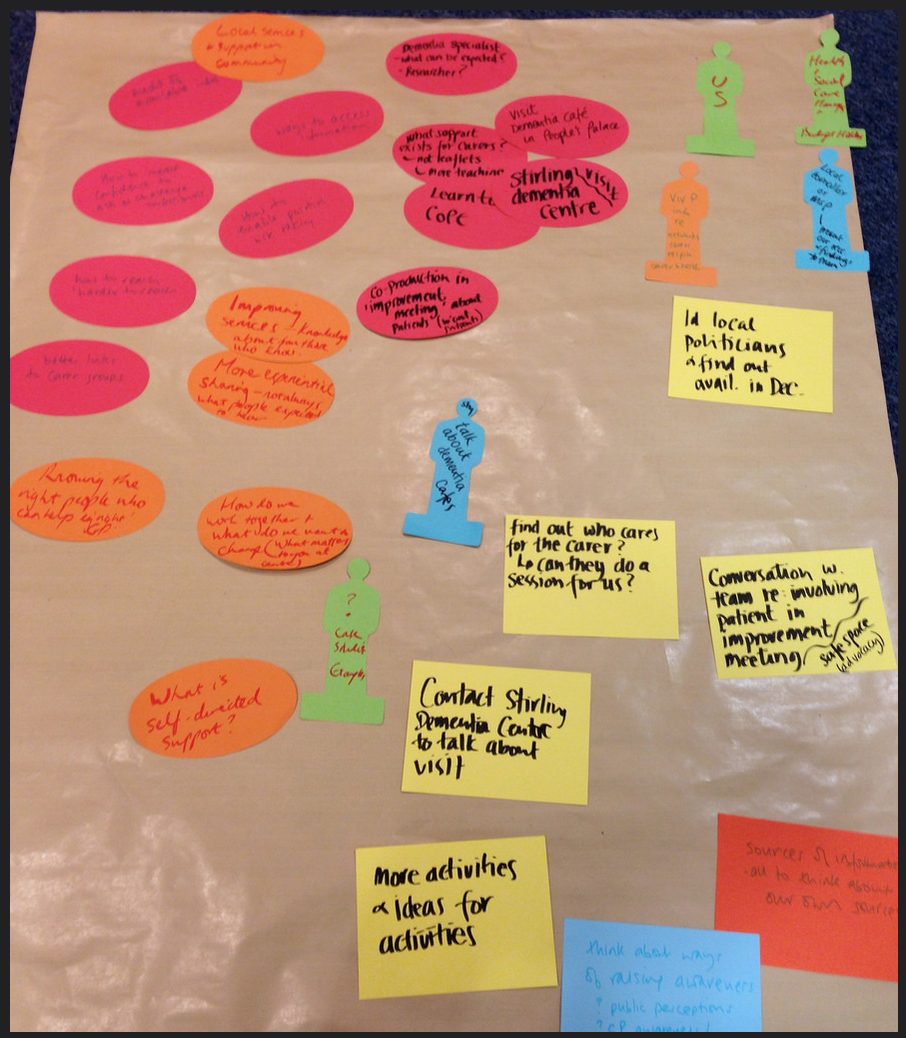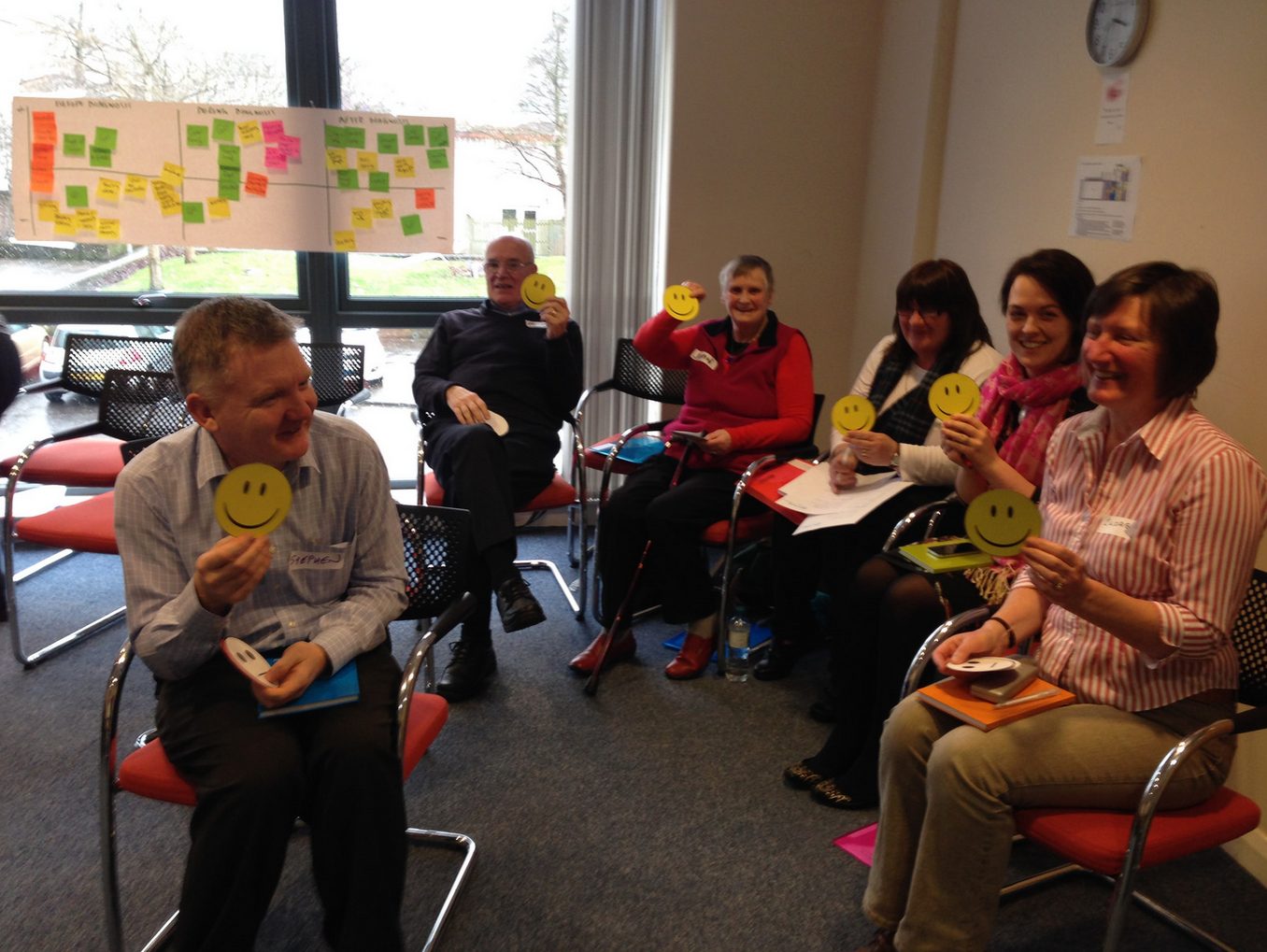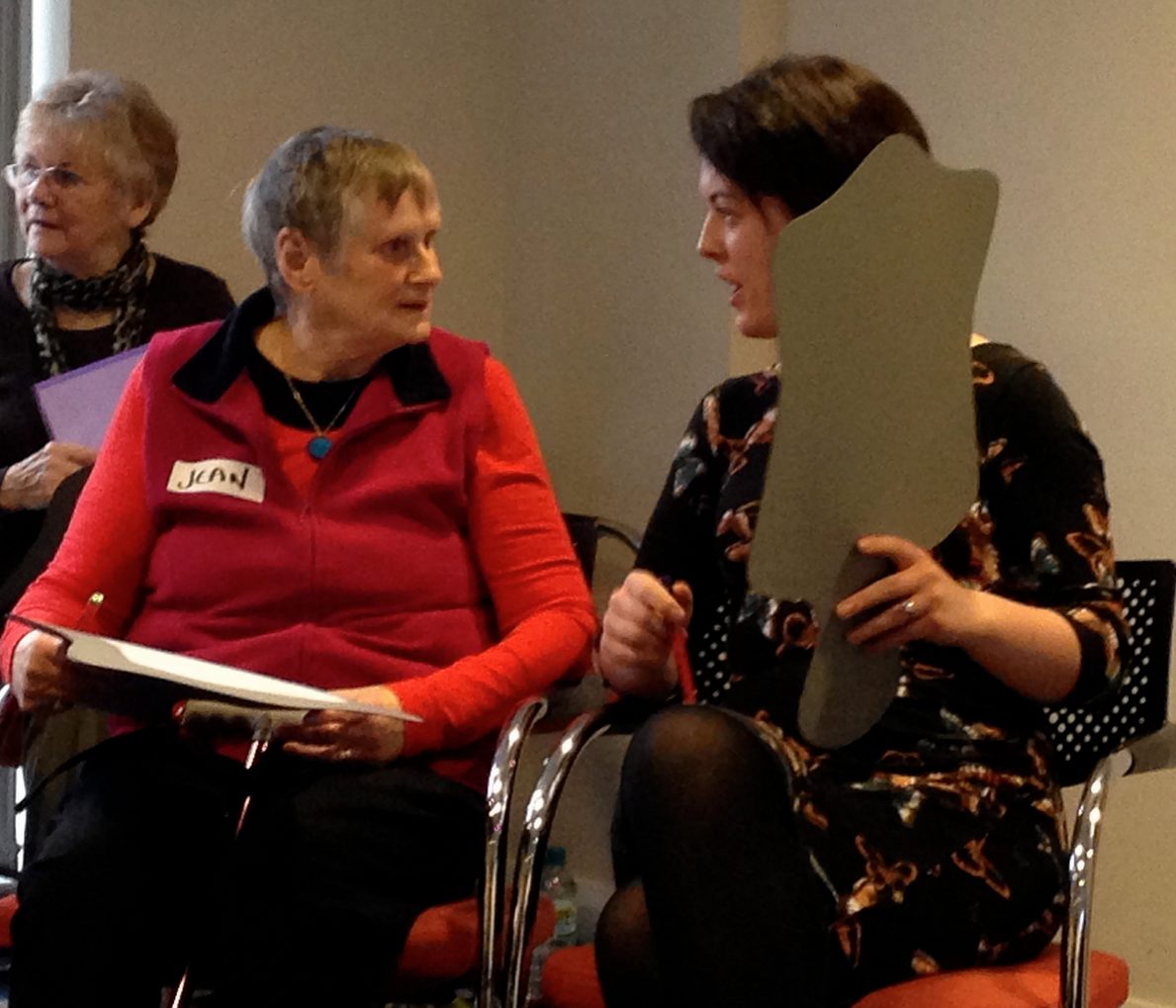 Group members getting to know each other using reflective ‘mirrors’
Group members getting to know each other using reflective ‘mirrors’
For an overview of the approach we took in this project check out the Approach applied in KiP page. This explains that the process we were working through was to learn, plan and do together.
This was the first meeting where the whole group got together. It was an opportunity to learn about each other and share our understanding of dementia. You can view our programme, and our goals for the day were to:
- Connect up and build relationships
- Share expectations about what we want to achieve
- Agree how we want to work together
- Agree homework and next steps
Connecting up
We wanted people who didn’t know each other to start to connect about things we normally discuss with our friends. Normally, these conversations take time to emerge. We wanted to ‘speed up the process’ a little. Inspired by life history work, and conscious that past memories can be brighter for people living with dementia we asked people to talk about: where they were born, their favourite things, a song, actor or the teacher they liked best at school, as well as happy experiences such as their favourite holiday.
To support this conversation we created large handheld ‘mirrors’ with space to insert A4 sheets of paper so people could write down other people’s answers. This visual ‘reflection’ can help people learn about each other and see who they are. Having a biography of important information about someone’s life can be important as their memory fails. Making it possible for others to develop individual relationships with them and provide personalised care. For more information on this kind of approach the Alzheimer Society has put together a ‘Remembering together’ leaflet.
Working together agreement
We also asked the group to create a working together agreement and gave them a suggested version to help start this activity. This is the Working Together Agreement they produced and we typed up afterwards so we could use it at each meeting.
Communication
To support group members to communicate effectively during and between meetings, we drew out of the working together agreement that people would like others to:
- Speak up
- Avoid making the room too noisy
- Mix the small groups up more
- Feel free to ask if you don’t understand what is being spoken about
We also watched a film about communication, and proposed a ‘parking lot’ for words the group considered might get in the way of effective communication.
‘parking lot’ for jargon
In addition, we agreed that red cards were to be held in the air if a group member wanted to stop the conversation. This approach was popular as people saw it as analogous to the red cards used at football matches. Having said this, after the first meeting, no one felt the need to use them! I’d like to think this was a reflection of the fact that the group felt free enough to speak their mind.
Red card
Introducing co-production
The group identified ‘co-production’ as jargon, however this is a term that would be heard a lot in this project and therefore we felt that it would be useful for the group to explore what co-production means. To introduce the concept of co-production we watched the video the parable of blobs and squares. The group thought the film was interesting but that people spoke too quickly. There was also a debate about why the squares were bigger than the blobs if the theme was equal partnership? An alternative film is Co-production by SPICE.
https://www.youtube.com/watch?v=egav5xjb-lg
After watching the video we engaged in small group discussions about what we do in our everyday lives that is co-produced and what we thought the benefits of co-production could be. People suggested that co-production is ‘about a skills-mix and bringing people together to get a result- getting the washing done, fed etc’ and that ‘we do it [work this way] every day’. People also asked why the term ‘co-production’ was used when everyday language, such as ‘working together’ could be used.
Exploring person-centred care and support
We asked all group members (professionals and those with lived experience), to consider what person-centred care meant to them. This involved reflecting on: their experiences of accessing and/or providing good person-centred care; what could have been better; and what help or support mattered most to them. We asked individuals to write their answer on a card and place the card in an envelope. The envelopes were then passed around the group and when the music we played, stopped, answers were read aloud and discussed.
Here are some examples of answers on the cards:
What’s been good person-centred care?
- support from a physiotherapist who took time to consider me as a whole person when developing a treatment plan
- help from the team at the Glenkirk centre
- community nurse providing helpful information
- receiving support from health services, that make you feel cared for
Practitioners added:
- listening to family and patient’s wishes and preferences
- getting closer to what an individual needs and wants rather than fitting people into services
What could have been better?
- GP initial dismissal and repeat appointments
- poor communication/conflicting advice
- support inflexible with lack of choice
What help or support mattered the most to you?
- being listened to
- people are friendly and introduce themselves
- family and friends
- feeling in control
- sharing with others who have similar experiences
Identifying opportunities for improving person-centred care
After this we worked in three small groups and gave each group a persona of a person who has dementia. We asked each group to map key points in their persona’s journey to illustrate positive and negative experiences before, during and after receiving a diagnosis of dementia. We then used these stories to reflect on each persona’s experience and discuss how it could have been improved.
‘Carol’s experience’
‘Gordon’s experience’
‘Beryl’s experience’
We were mindful that most of the group were meeting for the first time and therefore exercises were devised so that group members didn’t need to bring in their personal experiences, unless they wanted to. In discussions, group members were able to explore the persona’s situation and when people felt comfortable they could include their own experiences where relevant.
Fears, worries and uncertainty were frequently mentioned particularly in the ‘before’ and ‘during’ diagnosis phases. Feeling alone and finding it difficult to tell family and friends about the diagnosis were also mentioned as was inconsistency in support from professionals. The discussions suggested that consistent support from professionals as well as reliable social support from friends and family were potential areas for improvement.
Future meetings: getting the group to help set the agenda
Inspired by one of the IRISS D cards we asked the group to help set the future agenda. We adapted the letting go of control card and asked people in small groups to think about:
- What else do we need to know/learn about to bring back to the group?
- Who can help us? (from within the group and what other expertise do we need to bring in?)
- What do we need to do between now and the next session to make some/all of this happen?
Feedback included:
What do we need to know? – how to access information, what is it we want to change? what local services support the community? how to link with carers’ groups?
Who can help us? – we can help ourselves, local politicians or councillors, Stirling dementia centre, dementia cafés, health and social care managers
What do we need to do?- arrange visit to dementia centre, arrange to visit local dementia café, conversations with colleagues to share ideas
Here’s how we shared feedback from this discussion
Homework
As this was the first meeting of the group, we decided to set the homework. A good place to start we felt, was asking group members to begin with themselves. We asked them to keep a journal/diary of personal reflections on i) what person-centred care means to me in my life (or care and support that is centred around me) and ii) what person-centred care and support should look like. These reflections would then be shared with the group at the next session.
Evaluation and feedback
We went for an ‘evaluation-lite’ approach, asking small groups to reflect on the following and then feed back.
What’s your ‘gut reaction’ to the day – with smiley, not so sure and unhappy faces provided for them to choose from. We got a smiley face from everyone except one ‘not so sure’ response.
Positive responses from the group
We also asked three questions and asked for people’s thoughts:
What went well?
- Small group work
- Films
- Different formats
What could have been better?
- Better lunch – including more vegetarian.
- More breaks
- Points were also made at different points in the day about noise levels and it was suggested that we mix groups up in a more organised rather than self-selecting way.
What will you take away from today?
- Good atmosphere
- Everyone has taken part
- Good group

